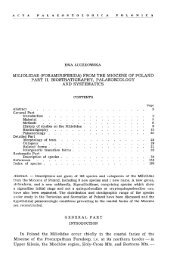Mass estimation in fossil sloths (Xenarthra, Folivora) from the Early ...
Mass estimation in fossil sloths (Xenarthra, Folivora) from the Early ...
Mass estimation in fossil sloths (Xenarthra, Folivora) from the Early ...
You also want an ePaper? Increase the reach of your titles
YUMPU automatically turns print PDFs into web optimized ePapers that Google loves.
<strong>Mass</strong> <strong>estimation</strong> <strong>in</strong> <strong>fossil</strong> <strong>sloths</strong> (<strong>Xenarthra</strong>, <strong>Folivora</strong>) <strong>from</strong> <strong>the</strong> <strong>Early</strong> Miocene Santa<br />
Cruz Formation of Patagonia, Argent<strong>in</strong>a<br />
NÉSTOR TOLEDO, GUILLERMO HERNÁN CASSINI, SERGIO FABIÁN VIZCAÍNO,<br />
AND M. SUSANA BARGO<br />
Toledo, N., Cass<strong>in</strong>i, G.H., Vizcaíno, S.F., and Bargo, M.S. 201X. <strong>Mass</strong> <strong>estimation</strong> <strong>in</strong> <strong>fossil</strong> <strong>sloths</strong> (<strong>Xenarthra</strong>,<br />
<strong>Folivora</strong>) <strong>from</strong> <strong>the</strong> <strong>Early</strong> Miocene Santa Cruz Formation of Patagonia, Argent<strong>in</strong>a. Acta Palaeontologica<br />
Polonica 5X (X): xxx-xxx. http://dx.doi.org/10.4202/app.2012.0009<br />
Miocene deposits of <strong>the</strong> Santa Cruz Formation, Patagonia, comprise a diverse and excellently<br />
preserved vertebrate fauna, allow<strong>in</strong>g detailed paleobiological and paleoecological studies based on<br />
three ecological parameters: body mass, diet and substrate preference. In contrast to <strong>the</strong> small and<br />
arboreal extant <strong>sloths</strong>, Bradypus and Choloepus, Santacrucian <strong>sloths</strong> were much more diverse and<br />
larger, and comprised 11 genera previously characterized as arboreal or climb<strong>in</strong>g forms. Here, we<br />
focus on body mass <strong>estimation</strong> based on measurements of postcranial elements. We present a<br />
morphometric database compris<strong>in</strong>g 64 l<strong>in</strong>ear, base-ten logged variables applied to Santacrucian <strong>sloths</strong><br />
and a wide sample of extant mammals, as well as <strong>the</strong> body mass of <strong>the</strong> extant taxa as reported <strong>in</strong> <strong>the</strong><br />
literature. To detect any potential phylogenetical bias, we performed a variance decomposition test on<br />
our sample of extant mammals. Based on four orthogram statistics, logged body mass was found not<br />
to be dependent on phylogenetic tree topology. Predictive equations for <strong>the</strong> body mass of extant<br />
mammals were generated through multiple regression analysis, us<strong>in</strong>g weight<strong>in</strong>g procedures to avoid<br />
taxonomic biases and stepwise analysis to discard redundant variables. Us<strong>in</strong>g this procedure, we<br />
derived separate equations for <strong>the</strong> scapula, humerus, radius, ulna, pelvis, femur, tibia plus fibula,<br />
astragalus, and calcaneum. These equations were <strong>the</strong>n applied to estimate <strong>the</strong> body mass of our<br />
sample of Santacrucian <strong>sloths</strong>. We obta<strong>in</strong>ed an average body mass of about 70 kg for <strong>the</strong><br />
megalonychid Eucholoeops. Among stem mega<strong>the</strong>rioids, Hapalops ranged between 30 and 80 kg,<br />
Analcimorphus was estimated at 67 kg, and Schismo<strong>the</strong>rium at 44 kg. Larger genera <strong>in</strong>cluded <strong>the</strong><br />
mega<strong>the</strong>riid Prepo<strong>the</strong>rium (~123 kg), and <strong>the</strong> mylodontids Analci<strong>the</strong>rium (~88 kg) and Nema<strong>the</strong>rium<br />
(~89 kg). The medium to large body size of Santacrucian <strong>sloths</strong> imposed constra<strong>in</strong>ts on <strong>the</strong>ir climb<strong>in</strong>g<br />
abilities. Megalonychids and stem mega<strong>the</strong>rioids were likely unable to access <strong>the</strong> f<strong>in</strong>est branches,<br />
while mega<strong>the</strong>riids and mylodonts were more terrestrial forms.<br />
Keywords: Santacrucian <strong>sloths</strong>, body mass, substrate preference, paleobiology, Miocene,<br />
Argent<strong>in</strong>a.<br />
Runn<strong>in</strong>g head: Body mass <strong>estimation</strong> <strong>in</strong> Santacrucian <strong>sloths</strong><br />
Néstor Toledo [ntoledo@fcnym.unlp.edu.ar] and Sergio Fabián Vizcaíno<br />
[vizca<strong>in</strong>o@fcnym.unlp.edu.ar], División Paleontología de Vertebrados, Museo de La Plata,<br />
Paseo del Bosque s⁄n, B1900FWA, La Plata, Buenos Aires, Argent<strong>in</strong>a and CONICET -<br />
Consejo Nacional de Investigaciones Científicas y Técnicas, Argent<strong>in</strong>a;<br />
Guillermo Hernán Cass<strong>in</strong>i [gcass<strong>in</strong>i@unlu.edu.ar], Departamento de Ciencias Básicas,<br />
Universidad Nacional de Luján, Ruta 5 y Av. Constitución, B6700, Luján, Buenos Aires,<br />
Argent<strong>in</strong>a; Consejo Nacional de Investigaciones Científicas y Técnicas, División<br />
Mastozoología, Museo Argent<strong>in</strong>o de Ciencias Naturales “Bernard<strong>in</strong>o Rivadavia” Av. Angel<br />
Gallardo 470, C1405DJR, Ciudad Autónoma de Buenos Aires, Argent<strong>in</strong>a and CONICET -<br />
Consejo Nacional de Investigaciones Científicas y Técnicas, Argent<strong>in</strong>a;<br />
M. Susana Bargo [msbargo@fcnym.unlp.edu.ar], División Paleontología de Vertebrados,<br />
Museo de La Plata, Paseo del Bosque s⁄n, B1900FWA, La Plata, Buenos Aires, Argent<strong>in</strong>a<br />
and CIC – Comisión de Investigaciones Científicas, Prov<strong>in</strong>cia de Buenos Aires, Argent<strong>in</strong>a.<br />
Received 20 January 2012, accepted 22 August 2012, available onl<strong>in</strong>e 7 September 2012.<br />
1<br />
1
















